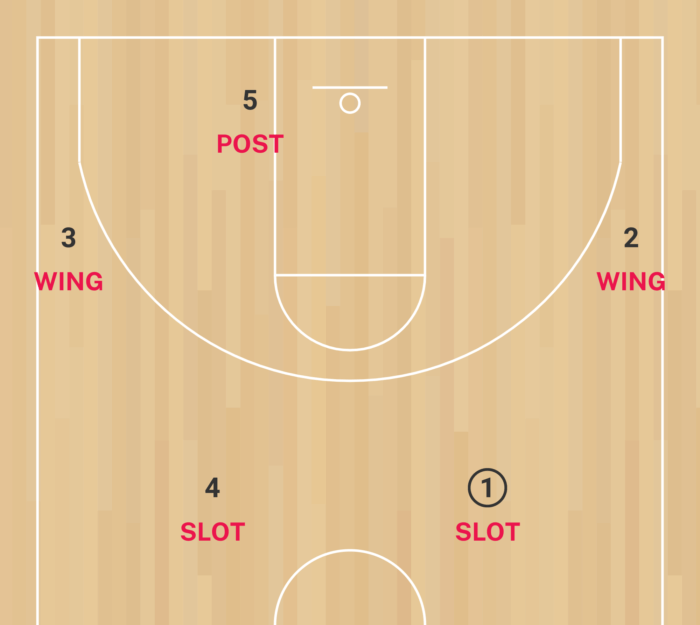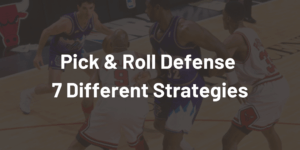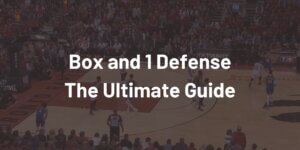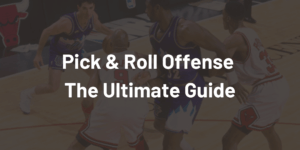The Princeton Offense was created by legendary college coach Pete Carrill, the head coach at Princeton University from 1967-1996. The offense became popular when under-matched Princeton teams started nearly upsetting powerhouse teams like UCLA in the NCAA Tournament. After a few big wins, other coaches from across the country started to implement the Princeton Offense themselves.
The offense is very popular today because it emphasizes spacing, timing, and cutting. It is very difficult to defend, and is aesthetically pleasing to watch. It also gives the underdog a unique advantage and counteracts more physical, athletic, and aggressive defensive teams.
Regardless of your level of play, I'll guarantee you will find elements of the Princeton Offense that can be applied to your teams.
Why is the Princeton Offense such a deadly offensive weapon?
- The offense encourages excellent spacing. The initial alignment within Princeton moves players up and higher off of the baseline. What does this open up? A lot of backdoors, cuts, and space near the rim where there is no help defender.
- There is an emphasis on ball and player movement. While there are certainly plenty of opportunities for dribble penetration within this offense, at its core it is an offense that has a lot of ball reversals, cutting, false motion, and offensive reads.
- A lot of opportunities for backdoor cuts. As mentioned before, since your offense is positioned higher, it can open up opportunities for more backdoor cuts. This is highly effective against teams that apply a lot of defensive pressure or deny one pass away.
- Screening and cutting is difficult to defend. A lot of modern basketball offenses focus on dribble penetration and paint touches. With Princeton, your players will be setting a lot more screens and reading those screens and the defense. Not a lot of teams are used to defending these types of actions.
- You can flow from Princeton into your conceptual offense. Hopefully, as a coach, you have trained your players to know what to do if a play doesn’t work or you don’t score off of the initial action. You can do the same thing with Princeton. A lot of teams even flow into Dribble Drive Motion from Princeton (more on this later in the article).
- Anyone can run this (or at least parts of it). There’s a common belief that Princeton can only be run with players that have a high basketball intelligence. Obviously, there is some truth to this. But, this offense and its basic precepts can be taught on just about any level. It’s like any other offense, skill, or concept - you must provide appropriate repetitions for growth and understanding to occur. You get what you emphasize.
Rules of the Princeton Offense
- Every cut must be a cut to score. There is less dribble penetration in this offense, so teams must put pressure on the rim with their cuts. If players do not cut to score (meaning - hard, with purpose, and all the way to the rim) every time, it will be an easy offense to defend.
- Be patient with cutters and let the play develop. If you have the ball in your hands, wait to see if the play develops. A lot of times, it will be easy to just reverse the ball or move on to the next part of the play. However, openings in the Princeton Offense sometimes require just a little bit more time.
- Don’t be a robot! Yes, you are running certain actions on offense, but you still must be able to adapt to the defense. If you’re being overplayed, go backdoor! If the defender is pressuring the ball, drive to the rim. Run the offense, but don’t be a robot.
- Catch and face. With so much cutting to the rim, players must catch and face the basket on EVERY single catch. This will allow them to see the play develop and hit open cutters with more ease.
- Read screens. As a cutter, it’s your job to make the defense wrong every play. If a defender is trailing you, cut to the rim. If they are overplaying you, reject the screen and go backdoor. If they are sagging, pop or flare.
Princeton Starting Alignment

The Princeton Offense starts with a 2-2-1 formation, featuring two players positioned at the top of the key (1 and 4), one player on each wing (2 and 3), and a player stationed in the low post on the ball-side (5). Notably, all four perimeter players are considered positionless, and even the low post player doesn't necessarily require dominant low post skills.
In this setup, the post player plays a significant role as a passer in various offensive actions. The offense can benefit greatly from having a high-IQ player in this position, regardless of their height compared to traditional big players.
Princeton Point Series
This is how Princeton Point typically begins and is initiated.
- From the Princeton alignment, Point begins with the high player opposite the ball (4 in the diagram) cutting through the elbow to the opposite corner.
- At the same time, 5 is cutting up the lane to receive a pass from 1. If 5 times it correctly, he can almost run his defender into 4’s cut to make this entry pass an easy one. Teams will often try to deny this pass. If they do, players should just go backdoor for an open layup.
- After 1 passes to 5, we are into Point.
After the initiating action from Point:
- 1 sets a screen for 3 (1 cuts IN and then OUT to get the proper angle)
- 3 uses 1's screen
- In this clip, 3 rejects the screen and goes backdoor. This is the most common action.
- 3 can also tight curl around the screen.
- 5 looks for 3 on the cut or for 3 posting up in the lane
- 1 pops out
- 5 passes to 1 (1 will sometimes be open for a shot here or able to rip and drive opposite)
- 3 finishes the cut to opposite corner
- 5 follows the pass to 1 with a ball screen (or runs dribble handoff with 1)
- 5 rolls to the rim
- 4 replaces
- 1 looks to make the play
What you do after this is up to what you run offensively. You can flow into Princeton, run another concept based offense, or pull it back out to "set it up".
Coaching Points:
- One option that 1 has is to go AWAY from 5.
- 1 initiates their screen away by first cutting IN and then OUT. This helps create a better angle for 3 when they cut.
- Typically, 3 is going to “reject” the screen (act like they are going to use it, but then cut backdoor) and cut to the rim. This is where you see a lot of the backdoor cuts for layups on video highlights.
- Another option for 3 is to “tight curl” the screen. When 3 does this, they are still going to cut to the rim but are actually using the screen by 1. This is a good cut to use if the defense is trailing behind the cutter.
- A third option would be for 3 to curl/pop the screen for an outside shot. If 3’s defender sinks low, this is a good option.
- An advanced option would also be for 1 to “slip” to the rim. If you’ve run AWAY a few times in a row, 1’s defender might start to cheat. This is a great time to fake the screen, cut to the rim, and catch the defender sleeping.
- And FINALLY, to get a post touch, you could have 3 cut into the paint, turn, seal, and duck in. There’s not a lot of help opportunities from the perimeter and you may be able to get a pass inside here.
- Once that initial AWAY screen happens, 1 pops back to the ball to receive a pass from 5
- There are some good options here as well: if 1 is denied they can go backdoor, sometimes 1’s defender will help on 3’s cut and this will leave 1 open for a jumper, sometimes 1’s defender will close out late allowing 1 an opportunity to drive
- Typically, 5 just reverses to 1
- After 1 receives the pass, 5 follows for a ballscreen
- 5 rolls to the rim, 4 replaces, and 1 makes the read
- If you don’t want to run a ball screen here, you could also have 5 run a dribble handoff with 1
After the initiating action from Point:
- 1 goes OVER 5
- 2 cuts to corner when they see 1 approaching to provide better spacing
- 2 uses 1's screen
- In this clip, 2 rejects the screen and goes backdoor. This is the most common action.
- 2 can also tight curl around the screen.
- 5 looks for 2 on the cut or for 2 posting up in the lane
- 5 passes to 1
- While 5 is passing to 1:
- 2 finishes their cut to opposite corner
- 3 fills
- 4 fills
- Now, 1 and 5 can run an empty ballscreen
- Here, 5 rolls to the rim but if 5 is a shooter this is a great opportunity for a pick and pop
What you do after this is up to what you run offensively. You can flow into Princeton, run another concept based offense, or pull it back out to "set it up".
Coaching Points:
- In OVER action, 1 cuts over the top of 5 and goes to set a screen for 2
- 2 moves to the corner to create more space to use the screen
- The same options from AWAY apply to this screen in OVER (see above)
- 2 empties out to the corner and this pushes 4 and 3 up in their spacing
- Now, 5 and 1 have the entire side of the floor to run an empty ballscreen
- 5 can roll or pop (if they are a shooter)
- 1 attacks off the bounce and either passes to 5, drives themselves, or kicks out to a teammate
Princeton Chin Series
- 1 and 3 dribble interchange with a handoff
- 2 and 4 cut and switch places
The thing to emphasize here is that each player is replacing their partner. 4 should end up in 2's spot and 2 should end up in 4's spot (and vice versa with 1 and 3).
- 3 takes 1-2 dribbles to get to their spot and then passes to 2
- 2 reverses to 4
- 5 sets the "chin" screen for 3
- 4 looks for 3 at the rim
- If 3 is not open, they cut to the corner
- Now, 5 sets a flare screen for 2
- 5 rolls/slips to the rim
- 4 either passes to 5 at the rim or 2 on the flare
- Now we are into our offense. We can run another play, run conceptual offense, or set Chin back up
Coaching Points:
- CHIN starts in the same alignment as POINT, but has entirely different actions.
- To initiate CHIN, 1 dribbles towards 3 for a dribble handoff. The players are not trying to score or get to the rim here, it’s simply a part of the play
- On the other side of the floor, 3 and 4 are exchanging spots
- When 3 gets the handoff, they take 1-2 dribbles higher and then reverse the ball to 3. While that’s happening, 5 is coming to set what is called a “chin screen”. This is basically a backscreen.
- 2 reverses to 4. 3 uses the screen. 2 looks to pass to 3.
- This might seem very easy to guard, but you’ll be amazed at how many times this option is actually available.
- After the chin screen, there are a few options for your team and you can run just about anything you’d like offensively…but the typical action is a flare screen between 5 and 2
- 5 sets the flare screen and 2 uses it. 2 needs to make sure they take their defender to the ball before they use the flare screen or it will not be effective.
- After the screen, 5 now rolls to the rim. This will be open at times because 5’s defender may help on the flare from 2.
Princeton Low Post Series
- Players begin in their typical Princeton Offense spots
- 1 passes to 3 and cuts to opposite corner
- 5 cuts to block
- 3 passes to 5
Coaching Points
- The starting positions are the same as Point and Chin, but now the offense is starting with a pass to the wing (3)
- 1 needs to cut deep and hard to the opposite corner to clear out space
- 5 must use their body to ensure this is an easy pass for 3, because the defense will try to take this entry pass away
- Coaches should teach 5 to use swim moves, spin moves, and deception to get open and make this as easy as possible for the entry passer
- There is also nothing wrong with 5 catching the ball more in the short corner or mid post rather than the low post; this may give 5 more space to see the cutting action and open up cutting options for players off the ball
- After the entry pass into 5, 3 screens away for 4
- 4 can either reject the screen and go backdoor (like this diagram) or curl
- 5 looks for 4 cutting to the rim
- If 4 doesn't receive the pass on the backdoor cut, they empty out to the corner
- 3 comes back to the ball
- 3 dribbles towards the middle to center the ball
- 2 cuts to the slot position
- 3 reverses to 2
- Now, 5 sets a screen for 3
- 3 uses the screen
- 2 tries to pass to 3 for the layup
- After setting the screen for 3, 5 immediately goes into a ballscreen with 2
- While this is happening, 3 and 1 are spacing to the wing and corner
- 5 rolls
- 2 makes the read and passes to the open player after using the ballscreen
Coaching Points
- Some teams will have 5 start on the ball side block instead of cutting to the block to receive the pass. Having 5 cut across opposite might make it tougher for the defense to defend, thus making that entry pass a little bit easier. You might also tell 5 to fake like they are cutting high (like they do in Point or Chin) and then flash to the block
- 4 could curl off the screen from 3, but the most effective action is typically rejecting and going backdoor
- On 4’s cut to the corner, they will want to make sure they are cutting wide enough to not bring help from x4 on 5
- When 3 is getting ready to reverse the ball to 2, they will want to take a few aggressive dribbles to center the ball. The goal here is to get back to that “slot” position (just like Chin)
- 3 should come to the ball to set up their cut when using the high back screen by 5
- If 5 is a shooter, this is very difficult to guard because of the threat of popping out for an open 3
- X5 now has to worry about defending the screen and helping x3 AND getting back out to contest a shot - this makes it very difficult to guard effectively
After these basic Point, Chin and Low Post actions actions, your offense can be as creative or basic as you like.
There is no shortage of plays, ideas, and videos available to help determine what best fits the needs of your team.
Advantages of the Princeton Offense
1. Your team will get much better at cutting, spacing, timing, and passing
Through mere repetition of drills in practice and running this offense, your players will have plenty of choices to improve at the fundamental skills of cutting, spacing, timing, and passing. Every player on your team will be put in countless game-like reads over the course of the season due to the style of the offense. They’ll automatically improve as basketball players.
2. Once your team gets the basics of the Princeton Offense, the defense is always wrong
- It takes a little time for your players to understand the basics of this offense, but once they do you can punish the defense even more
- When teams get used to defending the basic Point and Chin actions, you can add different cuts, different screens, and different wrinkles
- Your team could potentially get to the point where the coach doesn’t even need to call plays; the players can just flow into the offense based on the reads and what the defense gives them
3. All skills and experience levels can run this
- Even teams on the youth level can run the bare basics with this offense. They may not be able to run the offense on a complex level, but the basic rules still apply.
- Teams have been running Princeton action on the international and professional level for a long time now; it can be adapted to wherever you are playing
4. It can flow into other offenses
You don’t HAVE to run Princeton and Princeton alone. You can easily flow into offenses like Dribble Drive Motion or Continuity Ball Screen.
5. A lot of ball reversals means players touch the ball
- Since the ball is moving and changing sides of the floor fairly often, a lot of players get to touch the ball each possession. If you have fairly equally skilled players, this can be a good thing.
- This also helps each player feel like they are an important part of each possession and the team in general.
6. Teams aren’t used to defending these actions (this much)
- Since screening and cutting like the Princeton Offense isn’t as common as other offensive concepts and techniques, teams and players aren’t as equipped to defend them at a high level.
- Being able to master the screening, cutting, and passing actions makes your team a very difficult one to properly defend over the long haul of a game and season
7. Can be adjusted to put best players in best spots
The ball moves a lot in the Princeton Offense, but you can certainly be strategic about where you place your players within the offense.
Disadvantages of the Princeton Offense
1. It’s easy to lose sight of using your specific player strengths
If you primarily run Princeton, it’s easy to start to lose a little bit of control of who takes shots and when they take them. Since this is such a “sharing” offense, you might end up having some players who you’d prefer not taking so many shots…getting more looks.
2. Everyone does have to learn every position; more time to teach
If you primarily run Princeton, it’s easy to start to lose a little bit of control of who takes shots and when they take them. Since this is such a “sharing” offense, you might end up having some players who you’d prefer not taking so many shots…getting more looks.
3. Requires spacing and patience - two things youth players aren’t great at…yet
These two items also take time to develop. Some practice time that may be spent elsewhere will be spent on improving these offensive skills.
4. High pressure teams can be disruptive
If your team doesn’t handle pressure very well, they might get stuck in some spots with this offense. You must teach your team about counters, not being a “robot”, etc.
What Types of Teams Should Use the Princeton Offense?
This offense is good for teams on any level, but there are also certain types of teams that it would be most beneficial for.
Some teams that would benefit from the Princeton Offense are:
1. Smaller teams
Teams with smaller rosters and shorter players can expose bigger and slower defenders through the lifting of the floor in the Princeton Offense alignment. Removing offensive players from the rim forces the defense to leave the paint/help areas. When this happens, you can more easily expose their lack of speed and agility on the perimeter.
2. Teams with interchangeable parts
If a team has multiple players that can be play similar positions and have similar skills, this offense can cater to them very easily. It also makes the offense run with incredible rhythm. And the more rhythm and flow you have within your offense, the more quickly you can run actions…thus making you very difficult to defend.
3. Teams with shooters and ball handlers
- This is true with any offense, but it is especially true with Princeton.
- If you have a bunch of players who can space the floor with shooting, this offense will be deadly.
4. Teams that rep it out!
Also just like any other offense, the more you practice this the better your team will be at running it. Be consistent and intentional, stick with the offense even when you’re experiencing growing pains, and commit to the offense…good things will come!
The Princeton Offense has a reputation for being for smart teams with great ball handlers and decision-makers.
While this is true, there are still plenty of ways you can use the Princeton Offense to improve the overall offensive efficiency of your team
No matter what level you are coaching, these time tested concepts can be applied to the players and teams you coach!

Founder of thehoopsgeek.com. A passionate basketball enthusiast and coding geek, Andy combines a love for sports with technology.








